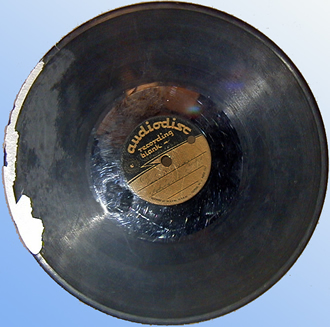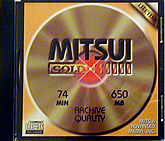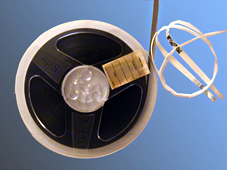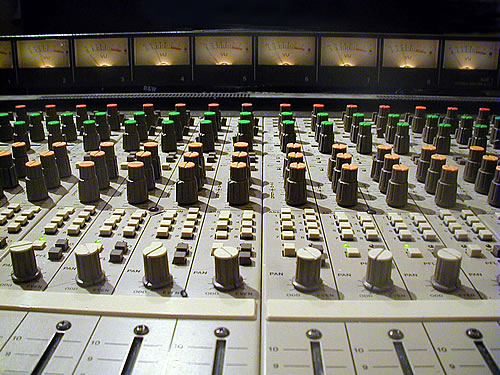AUDIO
RESTORATION AND REFORMATTING FOR PRESERVATION
Many
organizations have archival audio collections of historical
and artistic value. Over time, these documents deteriorate.
Some suffer accidental damage. Changing technology can make
the playback of these documents impossible due to a lack of
an appropriately functioning machine. Conservation involves
the treatment of damaged recordings and the reformatting of
collections in a more stable medium for the future.

Recordings
are reformatted on high quality Mitsui Gold Archive CD-R for
long life.

It
is highly recommended that more than one copy be made at the
time of reformatting. The second copy should be stored and not
circulated or loaned.

Analog
audio is converted to digital using industry standard software
such as Protools.
Audio
restoration will remove some of the unwanted noise with the
aim of hearing the recordings as they were first intended.
Audio
restoration prices are available on request. Prices depend on
how much work is required to restore the recordings. In many
cases accessing the condition of the collection is an important
first step to determine the amount of work required.
The
final product is a compact disk in CD audio format, playable
on any CD player, and/or a compact disk in wave file format
packaged in a jewel case with a printed label. Large collections
can be accompanied with a searchable database.

Top
Ten Things That Can Go Wrong with Audio Recordings
Reel
to Reel Tape.
1)
Dropout
The magnetic particles that hold the sound fall off the surface
of the tape causing a loss of volume in the sound. These dropout
particles then deposit themselves on the machines heads and
cause further loss of volume and high frequency making the tape
inaudible. The tape player must then be cleaned.
2)
Breakage
Over time the tape becomes dry and brittle and breaks apart
causing a complete loss of sound. The tape then has to be spliced
back together using splicing tape specific to this type of repair.
3)
Sticky-Shed
The tape changes chemically and becomes sticky, large amounts
of the magnetic particles fall off resulting in a complete loss
of sound and a failure of the tape to run on the playback machine.
The tapes can be made to play one last time using special conservation
techniques.
4)
Bad Splices
Old repairs or tapes that were edited have splices where the
glue in the repair tape breaks down and either comes apart or
sticks to adjacent layers of tape. In a case like this the splices
must be replaced.
5)
Lubricant Failure
Tape is made with a lubricant that helps the tape slide smoothly
through the tape path and over the heads of the playback machine.
Sometimes due to age, this lubricant is no-longer effective.
The results is a high pitched squealing noise heard from the
playback machine and an audible loss of speed stability heard
in the recording. In some cases the tape will come to a complete
stop or break. Treatment for this is possible.
6)
Partial Erasure
A poorly maintained machine can over time become magnetized.
A magnetic field is induced on the tape guides and playback
head. As the tape passes through the machine this causes the
tape to become partially erased. With repeated playbacks this
gets progressively worse and results in a permanent loss of
sound.
7)
Tape Stretch
Some formulations of tapes, since 1975 onward were recorded
on polyester base. This tape can stretch and cause an audible
pitch shifting of the sound. When the tape is accidently damaged
in this fashion repairs are not always possible.
8)
Scratching
A worn or badly maintained machine can scrape the
magnetic partials off the surface of the tape causing a loss
of sound quality.
9)
Misuse
An improperly threaded tape or a tape that is switched
from forward to reverse too quickly by someone who is unfamiliar
with the operation of a tape recorder can cause tape tangles
and breaks. These tapes need repair using proper conservation
techniques and materials.
10)
Poor Storage
A tape collection needs to be stored under proper climatic conditions.
Extremes of heat or cold, high or low humidity, are factors
that can accelerate the ageing of the tapes.
�
Cassette Tape Failures
The
tape used in audio cassettes is vulnerable to many of the
same factors and conditions as of open reel tape with the
additional problems of being thinner and smaller. The fact
that the tape is enclosed in a small plastic container makes
a cassette more difficult to repair.
1)
Transport Failure
Inside the cassette tape there is a plastic sleeve that helps
the tape move along the tape path. This can warp with time causing
speed variations. The tape must carefully be transferred to
a new body or case.
2)
Breakage
Similar to that on rel to reel with the added difficulty of
repairing a much smaller tape.
Digital Audio Tape (DAT)
Digital
Audio Tape is of very high quality in terms of sound and therefore
a very attractive production medium for oral history and other
recordings. However, in terms of preservation DAT is a rather
poor choice because it is extremely vulnerable to deterioration.
This is caused by the slow rate of transport of the tape and
the very thin tape used. DAT is NOT recommended as a preservation
media. It would seem that the practical life of a DAT tape is
about ten years.
1)
Breakage
Nearly impossible to repair. Can occur easily if the tape is
played on a dirty or defective player.
2)
Digital Errors
Caused by the loss of very small quantities of magnetic oxide
produces extremely loud clicking noise. (Much worse than on
conventional tape)
3)
Misuse
Failure to properly cue the tape during production can cause
a corruption of the index track (recorded along with the audio).
This can cause part of the tape to be unplayable on some machines.
4)
Sample rate error
At the time of production some machines allow the
use of non standard sample rates. This means that the tape is
not playable on standard dat machines.